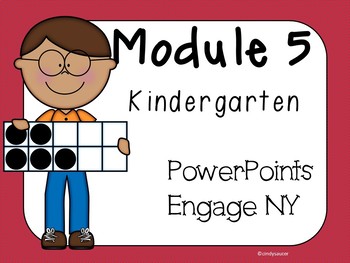Engage NY, Kindergarten Math, Module 5, Interactive PowerPoints
Cindy Saucer
4.3k Followers
Grade Levels
K
Subjects
Resource Type
Standards
CCSSK.CC.A.1
CCSSK.CC.A.2
CCSSK.CC.B.4
CCSSK.CC.B.5
CCSSK.NBT.A.1
Formats Included
- Zip
Pages
700 pages
Cindy Saucer
4.3k Followers
What educators are saying
These PowerPoints helped to organize the flow of my math lesson and also provided fun ways for students to practice their math skills.
Also included in
- This bundle is complete. It contains Modules 1 - 6.. . These lessons support the Engage NY curriculum. They give a visual to the students to guide instruction. I did not write this curriculum. These PowerPoints were created to aide in whole group instruction.Click below to view the Bundle of FuPrice $56.40Original Price $70.50Save $14.10
Description
This packet contains all 24 lessons of Module 5, Kindergarten Engage NY Math.
These lessons support the Engage NY curriculum. They give a visual to the students to guide instruction. I did not write this curriculum. These PowerPoints were created to aide in whole group instruction and keep students engaged.
Look at the Preview. It will show you part of a lesson in Module 5. This will give you an idea of what is included in this packet.
Included are the Fluency Activities, Concept Development, Application Problem, Problem Set, and Student Debrief for each day. There is animation so that answers can not be seen until students have had a chance to work the problems for themselves.
The clipart has been locked and secured. However, you can edit the words on each slide.
These lessons support the Engage NY curriculum. They give a visual to the students to guide instruction. I did not write this curriculum. These PowerPoints were created to aide in whole group instruction and keep students engaged.
Look at the Preview. It will show you part of a lesson in Module 5. This will give you an idea of what is included in this packet.
Included are the Fluency Activities, Concept Development, Application Problem, Problem Set, and Student Debrief for each day. There is animation so that answers can not be seen until students have had a chance to work the problems for themselves.
The clipart has been locked and secured. However, you can edit the words on each slide.
Total Pages
700 pages
Answer Key
N/A
Teaching Duration
N/A
Report this resource to TPT
Reported resources will be reviewed by our team. Report this resource to let us know if this resource violates TPT’s content guidelines.
Standards
to see state-specific standards (only available in the US).
CCSSK.CC.A.1
Count to 100 by ones and by tens.
CCSSK.CC.A.2
Count forward beginning from a given number within the known sequence (instead of having to begin at 1).
CCSSK.CC.B.4
Understand the relationship between numbers and quantities; connect counting to cardinality.
CCSSK.CC.B.5
Count to answer “how many?” questions about as many as 20 things arranged in a line, a rectangular array, or a circle, or as many as 10 things in a scattered configuration; given a number from 1-20, count out that many objects.
CCSSK.NBT.A.1
Compose and decompose numbers from 11 to 19 into ten ones and some further ones, e.g., by using objects or drawings, and record each composition or decomposition by a drawing or equation (e.g., 18 = 10 + 8); understand that these numbers are composed of ten ones and one, two, three, four, five, six, seven, eight, or nine ones.






